The Champion Professional: Issue 71
This issue:
- Overview of the Fifth National Aboriginal and Torres Strait Islander BBV and STI Strategy 2018-2022
- Closing the Gap at 414 Elizabeth Street
- How do we Close The Gap in Aboriginal and Torres Strait Islander people’s health?
- Hep C tests at Bluesfest!
- Live Hep C Free in Orange and Bathurst

Overview of the Fifth National Aboriginal and Torres Strait Islander BBV and STI Strategy 2018-2022
Five National Blood Borne Viruses (BBV) and Sexually Transmissible Infections (STI) Strategies were released in November 2018. The Champion has already given an overview of the Fifth National Hepatitis C Strategy (>>>click here) and Third National Hepatitis B Strategy (>>>click here).
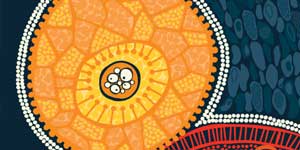
In this edition we present a summary of the Fifth National Aboriginal and Torres Strait Islander BBV and STI Strategy 2018-2022 (to read the report >>>click here).
As the report itself acknowledges, “Aboriginal and Torres Strait Islander peoples continue to be disproportionately impacted by blood borne viruses and sexually transmissible infections. While some communities have had considerable success in responding to BBV and STI, this is not a common experience across communities and much more needs to be done.” Overall, there have been a few achievements reported since the last strategy, and some key challenges still to be addressed and overcome.
New Diagnoses
Hepatitis B:
- In 2016, there were 176 notifications, with a rate of 31 per 100,000 compared to 23 per 100,000 in the non-Indigenous population (13.5% higher).
- At the end of 2016, it is estimated that over 24,000 Aboriginal and Torres Strait Islander people were living with chronic hep B infection, an estimated prevalence of 3.7%.
Hepatitis C:
- In 2016, there were 1,122 notifications, with a rate of 173 per 100,000 compared to 45 per 100,000 in the non-Indigenous population (38.4% higher).
Testing and care
There is limited information on the uptake of testing and treatment for hepatitis B; data is taken from the Australian NSP Survey, and are only available for hep C and HIV (testing only).
Hepatitis C:
- The proportion among PWID reporting a recent hep C test was higher than non-Indigenous participants between 2011 and 2014; however, it declined between 2014 and 2016 to close to the non-Indigenous proportion.
- In 2016, 19% participants in the survey reported treatment in the last 12 months, an increase from 3% in 2015. However, lifetime and recent uptake of treatment was lower in 2016 compared to non-Indigenous participants.
Notification data for blood borne viruses and sexually transmitted infections highlight the disproportionate rates of each STI and BBV relative to non-Indigenous Australians, recognising that some of this data lacks information to determine the true extent of infection and burden of disease.
Incompleteness of Aboriginal and Torres Strait Islander status in notification data arising from some clinical services is a contributing factor, and there is no available estimate on the prevalence of hep C among Aboriginal and Torres Strait Islander people. The data presented does not include all state and territories, as “50% completeness of Aboriginal and Torres Strait Islander status” was required for analysis and presentation of each BBV and STI.
Improving the collection and reporting of this field remains a priority area for BBV and STI surveillance.
Key achievements under the Fourth National Aboriginal and Torres Strait Islander BBV and STI Strategy 2014–2017
- Continued decline in hep B notification rates in younger age groups, reflecting the impact of Aboriginal and Torres Strait Islander childhood and adolescent vaccination programs.
- Uptake of sexual health services by young Aboriginal and Torres Strait Islander people increased, indicating that improvements have been made in the delivery of more accessible health services. This may also indicate improved health literacy among young Aboriginal and Torres Strait Islander people.
- The proportion of respondents from an Aboriginal and Torres Strait Islander background participating in the Australian NSP Survey increased from 11% in 2007 to 18% in 2017. However, it must be noted that during this period the prevalence of receptive needle and syringe sharing by Aboriginal and Torres Strait Islander program participants increased from 18% to 28%.
- There was progress in efforts to integrate sexual health services with primary health care, including through Aboriginal Community Controlled Health Services.
Significant challenges remaining, to be addressed and overcome:
- While progress has been notable in some areas, there are significant challenges remaining that must still be addressed and overcome. Over the past five years, new diagnoses for several BBV and STI, including HIV, hepatitis C and syphilis, have increased significantly among Aboriginal and Torres Strait Islander communities. These increases in new diagnoses may reflect an increase in testing—a key achievement of the previous strategies—but they could be a very concerning trend.
- The target of the previous strategy to increase the use of sterile injecting equipment for every episode was not met, with rates of receptive syringe sharing increasing from 18% in 2007 to 28% in 2016 among respondents to the Australian NSP Survey.
- There is currently limited data on treatment uptake among Aboriginal and Torres Strait Islander people living with hep B and hep C.
- There was an increase in the proportion of Aboriginal and Torres Strait Islander people who inject drugs and attended NSPs, reporting hep C treatment, with lifetime history of treatment increasing from 9% in 2012 to 19% in 2016, and treatment in the last 12 months increasing from 3% to 18%, reflecting the increased availability of direct-acting antiviral (DAA) treatment from March 2016.
- Over the five-year period of 2012–2016, there was a 25% increase in the notification rate of new hep C diagnoses in the Aboriginal and Torres Strait Islander population, increasing from 138 per 100,000 in 2012 to 173 per 100,000 in 2016. The rate in the non-Indigenous population remained stable over this period (at 44 per 100,000 in 2012 and 45 per 100,000 in 2016). In Aboriginal and Torres Strait Islander people aged under 25 years, there has been a 50% increase in the hep C notification rate over the past five years but a decrease in the rate in non-Indigenous people in this age group.
- Although the notification rate of newly diagnosed hep B halved from 2012 to 2016 in the Aboriginal and Torres Strait Islander population, in 2016 it was 1.4 times greater than the rate in the non-Indigenous population, at 31 per 100,000 compared with 23 per 100,000. At the end of 2016, 11% of the total number of people living with chronic hep B in Australia were Aboriginal and Torres Strait Islander despite composing 3% of the national population.
The limited progress demonstrated against the targets of the previous national strategy—included increase in rates of HIV and hep C; an increase in receptive needle and syringe sharing; and a lack of data to estimate diagnoses and treatment coverage for BBV in this population—indicates that a revitalised response is needed. Responses must be tailored and informed by the evidence base, including data on significant transmission routes which may differ from the non-Indigenous population. An understanding of the social determinants that lead to this greater impact is also required to ensure high-risk priority groups are effectively engaged.
Current Strategy
Goals:
- Significantly reduce the transmission of BBV and STI among Aboriginal and Torres Strait Islander people.
- Close the gap in BBV and STI incidence, prevalence, testing and treatment rates between Aboriginal and Torres Strait Islander and non-Indigenous populations.
- Reduce morbidity and mortality related to BBV and STI.
- Minimise the personal and social impact of BBV and STI.
- Minimise the negative impact of stigma, racism, discrimination, and legal and human rights issues on Aboriginal and Torres Strait Islander people’s health.
Targets by 2022:
- Achieve and maintain hep B childhood vaccination coverage of 95% at 12 and 24 months.
- Increase the use of sterile injecting equipment for every injecting episode.
- Reduce the number of newly acquired hep C infections by 60%.
- Increase the proportion of people living with hep C who are diagnosed to 90% and the cumulative proportion who have initiated direct acting antiviral treatment to 65%.
- Increase the proportion of people living with hep B who are diagnosed to 80%; receiving care to 50 %; and on antiviral treatment to 20%.
- Reduce hep C attributable mortality by 65%.
- Reduce hep B attributable mortality by 30%.
- Reduce the reported experience of stigma among Aboriginal and Torres Strait Islander people with BBV and STI, and the expression of stigma, in relation to BBV and STI status.
Closing the Gap at 414 Elizabeth Street
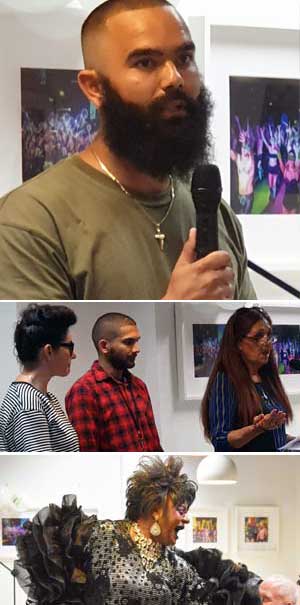
Hepatitis NSW, along with our Close the Gap 414 Working Group partners from 414 Elizabeth St, held a very successful Close The Gap event on Thursday 21 March. Close The Gap is part of the Australian Government’s strategy to reduce health and education disadvantage among Aboriginal and Torres Strait Islander people. For the last 10 years, schools, businesses and community groups have shown their support by marking National Close the Gap Day. Close the Gap Day is an opportunity to send our governments a clear message that Australians value health equality as a fundamental right for all.
Following a Welcome to Country by Mr Allen Murray from the Metropolitan Local Aboriginal Land Council, the event was kicked off by two songs from Redfern’s own drag artist, Nana Miss Koori, performing on her father’s country, Gadigal land. Kevin Heath, the Senior Aboriginal Health Promotion Officer, with South East Sydney Local Health District’s HARP unit then spoke about Aboriginal health generally, and specifically about his tremendous work with Indigenous youth. Other speakers included Close the Gap 414 Working Group representatives – Kerry Walker (Hepatitis NSW), Annaliese Constable (SWOP) and Jordan Wimbis (ACON).
Nana Miss Koori helped wrap the successful and well received event with a rousing rendition of Jessica Mauboy’s We Got Love.
So what has Hepatitis NSW been doing in consideration of Close The Gap? Alongside the other organisations at 414 Elizabeth St, we have formed Close The Gap 414 partnership, to work in collaboration, and reflect and plan on the work we do for and with Aboriginal and Torres Strait Islander peoples.
Members of the Close The Gap 414 partnership comprise Aboriginal Project Workers and senior staff from:
- Hepatitis NSW;
- NUAA (NSW Users and AIDS Association);
- ACON;
- HALC (HIV AIDS Legal Centre);
- SWOP (Sex Workers Outreach Project); and
- Positive Life.
We understand that, very often, our communities overlap, and by working together we can provide a holistic service approach. Further we can pool our limited resources, which allows for expanded service provision.
Over the past 12 months our Close The Gap 414 services have represented at the:
- 2018 NAIDOC week at the National Centre of Indigenous Excellence (NCIE) and Wayside Chapel,
- 2018 Aboriginal Women’s Health Forum in Dubbo,
- 2018 NSW Aboriginal Rugby League Knockout in Dubbo, and
- 2019 Yabun Festival in Camperdown.
We continue to consult and work together at every opportunity, including for the upcoming NAIDOC week.
Recent and upcoming Hepatitis NSW Aboriginal project activities include:
- Aboriginal Hepatitis B health promotion project “Taking it to the People”, delivered in Walgett, Gingie Mission and Pilliga;
- Aboriginal health promotion community event, held in Maroubra, in partnership with South East Sydney Local Health District;
- Upcoming Kooloora (hep B and hep C) Project, in partnership with South East Sydney LHD;
- Six Aboriginal focused hepatitis education sessions, to be delivered in Moree and Brewarrina, inclusive of two local Aboriginal drug and alcohol residential rehabilitation services, and one Aboriginal Medical Service.
As a final note, Hepatitis NSW has been working with Reconciliation Australia to finalise our Reconciliation Action Plan (RAP). We are very excited to advise that this has been provisionally approved and we hope to officially launch this document during NAIDOC Week in July 2019.
How do we Close The Gap in Aboriginal and Torres Strait Islander people’s health?
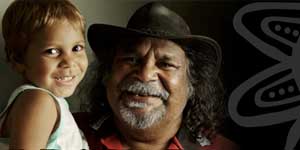
The following article is an edited excerpt of the speech given by Kerry Walker – Hepatitis NSW’s Aboriginal Project Officer – at our Close The Gap event last week.
Close the Gap is an Australian Government strategy that aims to reduce disadvantage among Aboriginal and Torres Strait Islander people, with respect to life expectancy, child mortality, access to early childhood education, educational achievement, and employment outcomes.
Major contributing factors to Aboriginal Australians lower life expectancy and poorer health outcomes originate from the effects of colonisation. Between one third, and one half of the life expectancy gap, may be explained by differences in the social determinates of health. They affect the health of people and can also influence how a person interacts with health and other services.
Australian politicians have held many campaigns to motivate people to work together to close the gap. Several of these campaigns are still running, but showing signs of minimal approval among Indigenous Australians. In 2018, the ten-year progress against the key areas of the framework indicated on three of the target areas were likely to be met, with ongoing concerns in areas such as education and school attendance, and health.
The latest report card on STIs and BBVs is not good for Aboriginal and Torres Strait Islander peoples (see article Overview of the Fifth National Aboriginal and Torres Strait Islander BBV and STI Strategy 2018-2022 above). So what is going wrong, why is it that the health gap is either remaining the same, and in some cases widening?
Most programs have been led by non-Indigenous people, and despite evidence it hasn’t and isn’t working, very little has changed. Basically Aboriginal and Torres Strait Islander people do not have a voice and input in how things should happen.
For example, the Statement from the Heart is a proposal by Aboriginal and Torres Strait Islander people. It would be a constitutional reform that to establish a constitutionally enshrined First Nations’ representative body that would advise parliament on policy affecting Indigenous peoples. Its implementation would commit Australia to a process of truth-telling of its colonial history through the establishment of a Makarrata commission.
But despite public willingness to consider its proposals, the key proposition – for a constitutionally enshrined Indigenous voice to parliament – has yet to gain bipartisan support.
The former Prime Minister Malcolm Turnbull said the proposal was neither “desirable nor capable of winning acceptance at referendum”, and that it was “inconsistent with democratic principles because only Indigenous Australians would be able to be or elect members of the representative body”, and would “inevitably become seen as a third chamber of parliament”.
Instead, the government announced a joint parliamentary committee to consider the Uluru Statement in the context of other proposals for constitutional reform.
And as Patrick Dodson states, “The longer we leave the command of the jurisdictions over us, the greater we become disinherited”.
Article image: ANTaR
Hep C tests at Bluesfest!
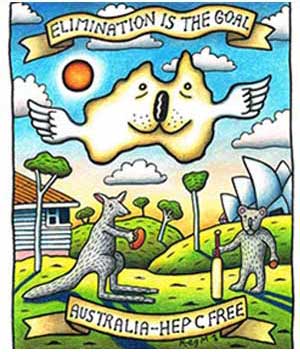
Bluesfest is Australia’s premier contemporary blues and roots music festival, showcasing music from around the world every Easter long weekend just north of Byron Bay. Hep C is already a ‘rock n roll’ brand, with a considerable impact on people associated with the music industry – for a brief who’s who list of some of them>>>CLICK HERE! It also happens that, because of the event’s demographics, a number of the thousands of people attending Bluesfest may be living with hep C.
Luckily, Hepatitis NSW was selected to have a charity stall at the festival providing testing for hep C and information on new Direct Acting Antiviral hep C cures.
Clinical and non-clinical staff of public liver clinics from Lismore, Port Macquarie, Coffs Harbour, and ACON Northern Rivers – plus Hepatitis NSW – will volunteer their time and expertise at a stall within the festival. Anyone at Bluesfest is welcome to visit us from Thursday 17 to Monday 22 April.
The stall will offer Dried Blood Spot (DBS) hep C testing for NSW residents. DBS is a self-collection method (not a self-test) where people collect samples and receive results later confidentiality, by SMS, email or phone call, and the person is linked to a service of their choice for follow-up. We will also offer free information resources, factsheets, booklets, and talks with trained hepatitis community and health workers.
T-shirts will be on sale with a specially-designed “Hep C Elimination in Australia” graphic by Reg Mombassa from Mental as Anything (see pic, right)!
Hopefully musicians and MCs will make announcements about the importance of people who might be living with hep C to go for testing and seek treatment. So if you’re going to Bluesfest, or know someone who is going, we’d love to see you at our stall!
For more on Bluesfest >>>CLICK HERE
Live Hep C Free in Orange and Bathurst
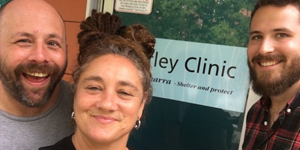
Hepatitis NSW spent a couple of days out in the beautiful Central West NSW area this month. Members of our Live Hep C Free program partnered with colleagues from NUAA (NSW Users and AIDS Association) to deliver education workshops, and to also encourage and assist people into hep C testing and treatment at priority settings in Orange and Bathurst.
We visited opioid treatment services, alcohol and other drug services, faith-based organisations, and a residential rehab.
We met some truly incredible and inspiring people across the region. We can’t wait to head back out in May to continue our support for the great work being done around hep C across the state.








